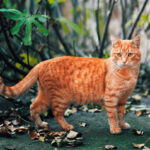Catnip, scientifically known as Nepeta cataria, is famous for its intoxicating effect on cats. A member of the mint family, this perennial herb is more than just a feline stimulant; it’s a versatile plant with a range of uses and interesting characteristics. Often confused with catmint, understanding the nuances of the catnip plant is key for gardeners and cat lovers alike.
:max_bytes(150000):strip_icc()/BHG-Catmint-vs-Catnip_102771828_CD_38326-1-87d5e7ab117648daa018d153cf398b80.jpg)
Understanding the Catnip Plant
Catnip is a vigorous perennial plant recognized by its gray-green foliage and somewhat weedy appearance. It can grow up to 3 feet tall, forming drifts of branching stems and leaves with toothed edges. Like other members of the mint family, catnip has square stems and produces small, two-lipped flowers that are attractive to pollinators. The leaves release a distinctive minty aroma, which some describe as slightly pungent.
The magic behind catnip’s allure for cats lies in a chemical compound called nepetalactone. This substance is structurally similar to feline pheromones and triggers a euphoric response in many cats. Interestingly, this chemical is believed to have evolved as a defense mechanism against pests, but instead, it attracts felines.
:max_bytes(150000):strip_icc()/BHG-Catnip-8SckTzIBq2A8xoAsF8yRo8-6e38e1d922d34006b709385dd5a2f610.jpg)
Catnip Plant vs. Catmint: Key Differences
While both catnip and catmint belong to the Nepeta genus and share similarities, there are crucial distinctions, especially when considering them for your garden or your cat.
Appearance: Catmint generally has a tidier, more ornamental appearance compared to catnip’s rangy and somewhat weedy growth habit. Catmint forms compact mounds with gray-green, lacy foliage and showier flower spikes in shades of purple, pink, or white. Catnip, on the other hand, has a more sprawling shape with less visually striking white flowers.
Landscaping: For landscaping purposes, catmint is often favored for its aesthetic appeal. Its neat shape and attractive flowers make it suitable for borders and garden beds. Catnip’s less refined look might be better suited for less formal areas or dedicated herb gardens.
Attraction to Cats: While both plants contain nepetalactone, the concentration can vary. Some cats may react more strongly to catnip, while others might show equal interest in catmint. It’s often a matter of individual feline preference.
Invasiveness: Catnip is known to be more aggressive and can be considered invasive in some regions. It readily reseeds and spreads, potentially becoming a nuisance if not managed. Catmint is generally less invasive, growing in clumps without spreading as rapidly.
:max_bytes(150000):strip_icc()/BHG-Catmint-Nepeta-8ToNu0JUKW0AxZCtOaTs07-22ca1a4bca04484f9a0091708fbd47af.jpg)
How to Grow Catnip Plant
Growing catnip is relatively easy, making it a rewarding addition to any garden, especially for cat owners.
Sunlight and Soil: Catnip thrives in full sun, requiring at least 8 hours of direct sunlight daily. While it prefers average, well-drained soil, catnip is quite adaptable and can tolerate poorer soil conditions.
Planting: You can start catnip from seeds or purchase potted plants from garden centers. Seeds can be sown directly in the garden after the last frost or started indoors a few weeks earlier. Potted plants can be planted in spring or early fall.
Care and Maintenance:
- Watering: Water regularly, especially during dry periods, to keep the soil consistently moist but not waterlogged. Once established, catnip is drought-tolerant.
- Fertilizing: Catnip doesn’t require fertilizer, especially if you amend the soil with compost before planting.
- Deadheading: While catnip flowers are not the main attraction, deadheading spent blooms can encourage bushier growth.
- Pruning: To maintain a neater shape and prevent excessive spreading, you can prune catnip stems back by half in midsummer. Save the clippings – your cat will appreciate them!
Managing Spread: If you’re concerned about catnip spreading aggressively, consider planting it in containers or in a designated area where it can be easily managed.
:max_bytes(150000):strip_icc()/nepeta-cats-pajamas-5616b5a8-a760cba3893f41649c07a854f5b7bd44.jpg)
Benefits of Catnip Plant
Beyond its obvious appeal to cats, the catnip plant offers several other benefits:
For Cats: Catnip provides enrichment and stimulation for cats. It can encourage playfulness, reduce stress, and make handling and training easier. However, not all cats react to catnip; the sensitivity is hereditary, with approximately 50-75% of cats being affected.
For the Garden: Catnip flowers attract pollinators like bees and butterflies, contributing to a healthy garden ecosystem. It is also deer-resistant, making it a useful plant in areas where deer are a problem.
Other Uses: Historically, catnip has been used in herbal remedies for humans, although scientific evidence for these uses is limited.
Conclusion
The catnip plant is a fascinating and beneficial herb, offering joy to cats and advantages to gardeners. Understanding its characteristics and how it differs from catmint allows you to make informed choices for your garden and your feline companions. Whether you’re looking to entertain your cat or add a resilient and pollinator-friendly plant to your landscape, catnip is a worthwhile choice. Just be prepared for the feline frenzy it may inspire!


